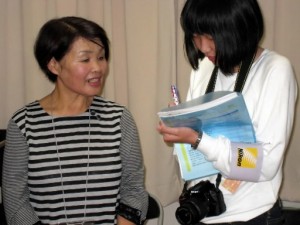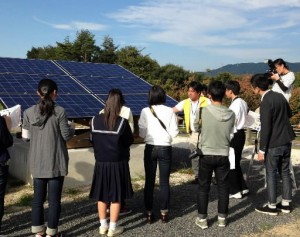Three and a half years after the Tohoku Disaster
Oct. 24, 2014
Living in the present: Junior writer reports from Koriyama, Fukushima Prefecture"
Nanase Shode, a junior writer for the Chugoku Shimbun, took part in a program in which junior high school students reported on the current situation in the Tohoku disaster area. As part of the program, which was sponsored by the Smile Tohoku Project, Ms. Shode, 15, a third-year junior high school student, talked with a woman who is still living in temporary housing in the city of Koriyama in Fukushima Prefecture three and a half years after the disaster. Looking at a fig tree she planted in front of her house, the woman said, “This way I can eat figs without worrying about radiation.” Ms. Shode was surprised by the references to radiation she heard in ordinary conversation. During the program she also visited Koriyama City Hall and Fukushima Airport, where she learned about new sources of energy and disaster prevention measures in the wake of the disaster.
About 2.5 km northwest of Koriyama Station is the Tomita-Wakamiyamae temporary housing, where people who lived in the town of Tomioka prior to the disaster reside. Tomioka was affected by the accident at the Fukushima No. 1 (Daiichi) nuclear power plant as well as the earthquake and tsunami. Towns within 20 km of the nuclear power plant are still subject to one of three designations – zones where returning is difficult, zones where residence is restricted and zones being prepared for the lifting of the evacuation order – and are uninhabitable. Their town offices are located in Koriyama.
On the grounds of the temporary housing is a support center for Tomioka residents, which features a local FM radio station. Set up after the disaster, the station continues to link Tomioka residents who have evacuated to locations throughout Japan. The Tohoku dialect they hear on the radio creates a bond among the residents.
Residents of the temporary housing gather to enjoy tea together and take pottery classes. At the center’s reception desk there is a box for donations to aid the victims of the recent landslides in Hiroshima and other disasters throughout the nation. Seeing that, I felt a sense of gratitude.
Some residents of the Tomita-Wakamiyamae temporary housing recount their experiences to others so that the disaster will not be forgotten. Tomoko Endo, 68, and Toshiko Aoki, 66, talked about what they saw at the time of the disaster and how they feel now.
Before the disaster Ms. Endo ran a livestock business in Tomioka. On the day of the disaster she was spreading fertilizer in the pastures when the ground suddenly began to shake. A steel tower was shaking so violently that it seemed it might topple over. With an eye on the tower, Ms. Endo fled, crawling on her hands and knees. Later, after hearing an order to evacuate over the community wireless system, she, her husband and their dog evacuated to Kawauchi, which borders Tomioka on the west.
Assuming she would be returning in two or three days, she took only one bag with her. Three and a half years later she has yet to return to her home. Her cattle were put down. She said she had received so many relief supplies from throughout Japan that she didn’t feel she should ask for anything more.
Ms. Aoki, who originally came to Tomioka as a teacher, regards the town as her “second home.” She works as an adviser for the local social welfare council. “It’s said we live in an information society, but the people who need information the most are not getting it,” she said. “It’s one thing to have an earthquake and tsunami, but the accident at the nuclear power plant was man-made. In their bid to host the Olympic Games in Tokyo, the government said things like ‘the leaks of contaminated water are under control’ or ‘Fukushima is a long way from Tokyo.’ We felt like we’d been abandoned.”
Many people continue to live as evacuees in the temporary housing, which was built under the assumption that residents would reside there for two years. “I just want the government to let us know what lies ahead,” Ms. Endo said.
Fukushima Prefecture has set a goal to meet all of its electricity needs with renewable energy by the year 2040. This initiative got underway in April when the city established a mega solar power plant at Fukushima Airport, in the center of the prefecture.
The plant is located site near the airport parking lot on a large tract of land of about 2 hectares. It features a total of 2,000 solar panels of 30 different types made by manufacturers both in Japan and overseas and generates enough electricity for about 330 households. The facility plays a role in informing the public about solar power, providing an opportunity for children to learn about energy and for business people to see various types of solar panels.
Takahiro Adachi, 24, a member of the Fukushima Recovery Solar and Agriculture Experience Association, provided an explanation of the plant. “It’s important for us to choose the energy source and lifestyle that suits us.” Electricity is part of our everyday lives, and methods of power generation power and its uses have a major impact on culture and civilization. In particular, nuclear power has the potential to destroy the earth. How to generate power is an issue that all of us must consider.
After the accident at the nuclear power plant, Koriyama was the first local government to undertake decontamination. Through the decontamination work, areas with high levels of radiation became apparent. After the disaster, solar panels were installed on the roof of city hall. The city took the lead in energy conservation and is working to cut the entire city’s power consumption.
In preparation for a future disaster, the city is establishing a new system for the procurement of supplies, water service and the dissemination of information. Kazuya Honda, 40, who is in charge of disaster preparedness, said, “Fukushima Prefecture had prepared for heavy water damage but the earthquake was far bigger than had been anticipated, and there was a lack of awareness of disaster-prevention measures.”
Earthquakes are one type of natural disaster that is difficult to predict. It is hard to take preventive measures in advance. But it should be possible to keep damage to a minimum by making preparations on a routine basis and by addressing the damage after an earthquake occurs. If members of a household discuss what they will do in the event of a disaster – where they will gather, what they will bring, how and where they will evacuate – precious lives may be saved.
(Originally published on October 20, 2014)









